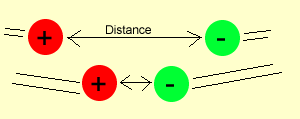Bonding
Attraction of electrons


|
Bonding Attraction of electrons |
|
| We saw earlier that atoms prefer to have certain electron configurations. We spoke of atoms losing and gaining electrons so that they achieve a certain stable electronic structure. That is, 8 electrons in their outer energy level, a full or an empty outer energy level. Atoms, though, do not have a brain with which to make decisions, and the ability to give or take electrons depends on electrostatic attraction between the positive nucleus and the negative electrons. | |
| Electrostatic forces come about due to the attraction or repulsion between positive and negative charges. Electrostatic forces, much like magnetic forces, are very weak when acting over long distances. |
 |
 |
The force increases as the distance between charges decreases or when the charge on each particle increases as the distance remains constant. |